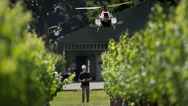RoboBees to the Rescue
- By Anna Rothschild
- Posted 10.03.13
- NOVA
As colony collapse disorder decimates beehives, scientists are developing mini drones, called RoboBees, to help pollinate our crops.
Transcript
RoboBees to the Rescue
Posted: October 3, 2013
As you’ve probably read in the news, bee populations worldwide have been decimated by something called “colony collapse disorder.” It’s unclear what has caused this scourge—it could be pesticides or parasites or the environment or all three. Biologist and epidemiologists are looking for a cure, but in the meantime, how can we effectively pollenate our crops? The answer might be drones… and I don’t just mean male bees. I mean robots.
Scientists at Harvard have created a “RoboBee,” a mini drone that weighs only about 80 milligrams—that’s one-thirtieth the weight of a U.S. penny. Its wings were designed to mimic those of the hover fly—those tiny insects you’ve seen that look like bees or wasps—but beat their wings so quickly that they seem to be suspended in space.
The RoboBee beats its wings over 100 times a second. But in order to stay so small and light, it can’t rely on motors or gears to accomplish the feat. Instead, it uses something called “piezoelectricity.” Piezoelectric materials can convert electricity into motion. Electricity is fed to the RoboBee through wires and stimulates tiny strips of a piezoelectric ceramic to contract like artificial muscle. Each contraction moves the wings and makes them flap.
These hovering drones are pretty impressive, but they’re not quite ready for launch. First of all, there are no batteries small enough to power them—right now, they’re still connected to their electricity source with wires. And they don’t yet have on-board computers to control their flight. But the hope is that one day the RoboBees will be untethered fliers, working together to solve problems like…how to pollinate an orchard. At least while we look for ways to get the real bees back in action.
Credits
PRODUCTION CREDITS
- Animated and Narrated by
- Anna Rothschild
- Cinematography by
- Steve McCarthy
- Sound by
- Mario Cardenas
- Original Footage
- © WGBH Educational Foundation 2013
MEDIA CREDITS
- Additional Footage
- Courtesy Harvard's Wyss Institute for Biologically Inspired Engineering
- (SLOW MOTION: Flying Hoverfly)
- © iStockphoto/Schroptschop
IMAGE
- (main image: RoboBee in Field)
- © WGBH Educational Foundation 2013
Related Links
-

Making More Stuff
Host David Pogue hits the road to explore the frontiers of invention and innovation.
-

Robots on the Farm
Advances in robotics, automation, and sensor networks are making farms more productive than ever.
-

Hive Mind
For bees, teamwork is critical in creating a functioning "brain."
-

New Ways to Use Drones
Although pioneered by the military, unmanned aircraft could soon become a common part of civilian life.

